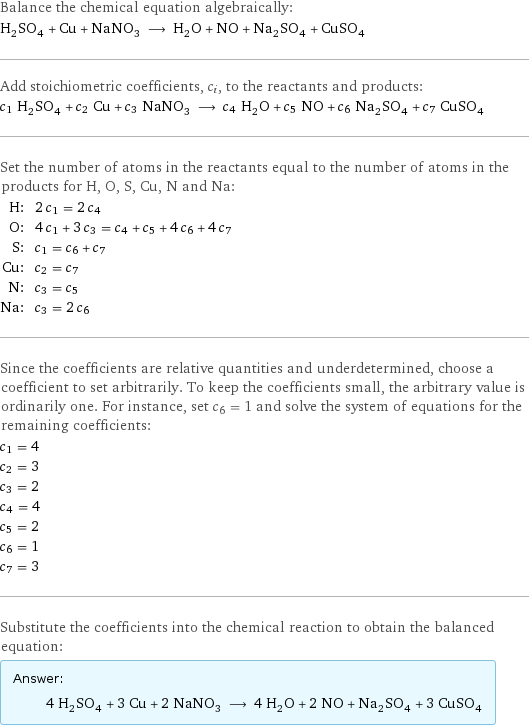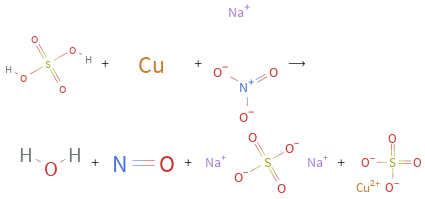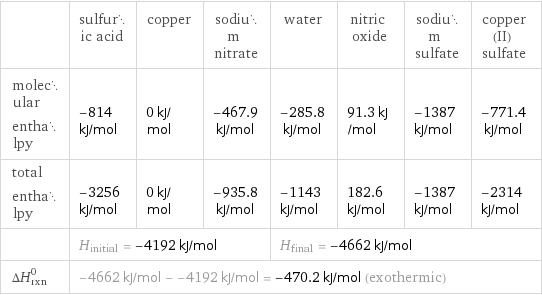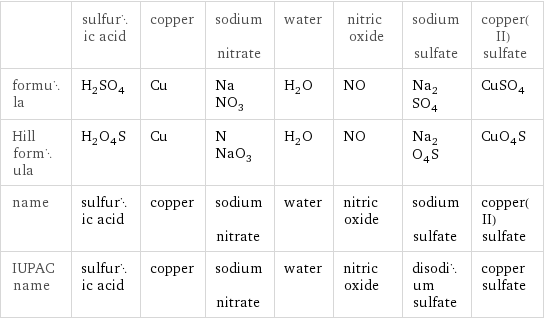Input interpretation

H_2SO_4 sulfuric acid + Cu copper + NaNO_3 sodium nitrate ⟶ H_2O water + NO nitric oxide + Na_2SO_4 sodium sulfate + CuSO_4 copper(II) sulfate
Balanced equation

Balance the chemical equation algebraically: H_2SO_4 + Cu + NaNO_3 ⟶ H_2O + NO + Na_2SO_4 + CuSO_4 Add stoichiometric coefficients, c_i, to the reactants and products: c_1 H_2SO_4 + c_2 Cu + c_3 NaNO_3 ⟶ c_4 H_2O + c_5 NO + c_6 Na_2SO_4 + c_7 CuSO_4 Set the number of atoms in the reactants equal to the number of atoms in the products for H, O, S, Cu, N and Na: H: | 2 c_1 = 2 c_4 O: | 4 c_1 + 3 c_3 = c_4 + c_5 + 4 c_6 + 4 c_7 S: | c_1 = c_6 + c_7 Cu: | c_2 = c_7 N: | c_3 = c_5 Na: | c_3 = 2 c_6 Since the coefficients are relative quantities and underdetermined, choose a coefficient to set arbitrarily. To keep the coefficients small, the arbitrary value is ordinarily one. For instance, set c_6 = 1 and solve the system of equations for the remaining coefficients: c_1 = 4 c_2 = 3 c_3 = 2 c_4 = 4 c_5 = 2 c_6 = 1 c_7 = 3 Substitute the coefficients into the chemical reaction to obtain the balanced equation: Answer: | | 4 H_2SO_4 + 3 Cu + 2 NaNO_3 ⟶ 4 H_2O + 2 NO + Na_2SO_4 + 3 CuSO_4
Structures

+ + ⟶ + + +
Names

sulfuric acid + copper + sodium nitrate ⟶ water + nitric oxide + sodium sulfate + copper(II) sulfate
Reaction thermodynamics
Enthalpy

| sulfuric acid | copper | sodium nitrate | water | nitric oxide | sodium sulfate | copper(II) sulfate molecular enthalpy | -814 kJ/mol | 0 kJ/mol | -467.9 kJ/mol | -285.8 kJ/mol | 91.3 kJ/mol | -1387 kJ/mol | -771.4 kJ/mol total enthalpy | -3256 kJ/mol | 0 kJ/mol | -935.8 kJ/mol | -1143 kJ/mol | 182.6 kJ/mol | -1387 kJ/mol | -2314 kJ/mol | H_initial = -4192 kJ/mol | | | H_final = -4662 kJ/mol | | | ΔH_rxn^0 | -4662 kJ/mol - -4192 kJ/mol = -470.2 kJ/mol (exothermic) | | | | | |
Equilibrium constant
![Construct the equilibrium constant, K, expression for: H_2SO_4 + Cu + NaNO_3 ⟶ H_2O + NO + Na_2SO_4 + CuSO_4 Plan: • Balance the chemical equation. • Determine the stoichiometric numbers. • Assemble the activity expression for each chemical species. • Use the activity expressions to build the equilibrium constant expression. Write the balanced chemical equation: 4 H_2SO_4 + 3 Cu + 2 NaNO_3 ⟶ 4 H_2O + 2 NO + Na_2SO_4 + 3 CuSO_4 Assign stoichiometric numbers, ν_i, using the stoichiometric coefficients, c_i, from the balanced chemical equation in the following manner: ν_i = -c_i for reactants and ν_i = c_i for products: chemical species | c_i | ν_i H_2SO_4 | 4 | -4 Cu | 3 | -3 NaNO_3 | 2 | -2 H_2O | 4 | 4 NO | 2 | 2 Na_2SO_4 | 1 | 1 CuSO_4 | 3 | 3 Assemble the activity expressions accounting for the state of matter and ν_i: chemical species | c_i | ν_i | activity expression H_2SO_4 | 4 | -4 | ([H2SO4])^(-4) Cu | 3 | -3 | ([Cu])^(-3) NaNO_3 | 2 | -2 | ([NaNO3])^(-2) H_2O | 4 | 4 | ([H2O])^4 NO | 2 | 2 | ([NO])^2 Na_2SO_4 | 1 | 1 | [Na2SO4] CuSO_4 | 3 | 3 | ([CuSO4])^3 The equilibrium constant symbol in the concentration basis is: K_c Mulitply the activity expressions to arrive at the K_c expression: Answer: | | K_c = ([H2SO4])^(-4) ([Cu])^(-3) ([NaNO3])^(-2) ([H2O])^4 ([NO])^2 [Na2SO4] ([CuSO4])^3 = (([H2O])^4 ([NO])^2 [Na2SO4] ([CuSO4])^3)/(([H2SO4])^4 ([Cu])^3 ([NaNO3])^2)](../image_source/ffdb345e4b33d8c5a2a501d227cdb077.png)
Construct the equilibrium constant, K, expression for: H_2SO_4 + Cu + NaNO_3 ⟶ H_2O + NO + Na_2SO_4 + CuSO_4 Plan: • Balance the chemical equation. • Determine the stoichiometric numbers. • Assemble the activity expression for each chemical species. • Use the activity expressions to build the equilibrium constant expression. Write the balanced chemical equation: 4 H_2SO_4 + 3 Cu + 2 NaNO_3 ⟶ 4 H_2O + 2 NO + Na_2SO_4 + 3 CuSO_4 Assign stoichiometric numbers, ν_i, using the stoichiometric coefficients, c_i, from the balanced chemical equation in the following manner: ν_i = -c_i for reactants and ν_i = c_i for products: chemical species | c_i | ν_i H_2SO_4 | 4 | -4 Cu | 3 | -3 NaNO_3 | 2 | -2 H_2O | 4 | 4 NO | 2 | 2 Na_2SO_4 | 1 | 1 CuSO_4 | 3 | 3 Assemble the activity expressions accounting for the state of matter and ν_i: chemical species | c_i | ν_i | activity expression H_2SO_4 | 4 | -4 | ([H2SO4])^(-4) Cu | 3 | -3 | ([Cu])^(-3) NaNO_3 | 2 | -2 | ([NaNO3])^(-2) H_2O | 4 | 4 | ([H2O])^4 NO | 2 | 2 | ([NO])^2 Na_2SO_4 | 1 | 1 | [Na2SO4] CuSO_4 | 3 | 3 | ([CuSO4])^3 The equilibrium constant symbol in the concentration basis is: K_c Mulitply the activity expressions to arrive at the K_c expression: Answer: | | K_c = ([H2SO4])^(-4) ([Cu])^(-3) ([NaNO3])^(-2) ([H2O])^4 ([NO])^2 [Na2SO4] ([CuSO4])^3 = (([H2O])^4 ([NO])^2 [Na2SO4] ([CuSO4])^3)/(([H2SO4])^4 ([Cu])^3 ([NaNO3])^2)
Rate of reaction
![Construct the rate of reaction expression for: H_2SO_4 + Cu + NaNO_3 ⟶ H_2O + NO + Na_2SO_4 + CuSO_4 Plan: • Balance the chemical equation. • Determine the stoichiometric numbers. • Assemble the rate term for each chemical species. • Write the rate of reaction expression. Write the balanced chemical equation: 4 H_2SO_4 + 3 Cu + 2 NaNO_3 ⟶ 4 H_2O + 2 NO + Na_2SO_4 + 3 CuSO_4 Assign stoichiometric numbers, ν_i, using the stoichiometric coefficients, c_i, from the balanced chemical equation in the following manner: ν_i = -c_i for reactants and ν_i = c_i for products: chemical species | c_i | ν_i H_2SO_4 | 4 | -4 Cu | 3 | -3 NaNO_3 | 2 | -2 H_2O | 4 | 4 NO | 2 | 2 Na_2SO_4 | 1 | 1 CuSO_4 | 3 | 3 The rate term for each chemical species, B_i, is 1/ν_i(Δ[B_i])/(Δt) where [B_i] is the amount concentration and t is time: chemical species | c_i | ν_i | rate term H_2SO_4 | 4 | -4 | -1/4 (Δ[H2SO4])/(Δt) Cu | 3 | -3 | -1/3 (Δ[Cu])/(Δt) NaNO_3 | 2 | -2 | -1/2 (Δ[NaNO3])/(Δt) H_2O | 4 | 4 | 1/4 (Δ[H2O])/(Δt) NO | 2 | 2 | 1/2 (Δ[NO])/(Δt) Na_2SO_4 | 1 | 1 | (Δ[Na2SO4])/(Δt) CuSO_4 | 3 | 3 | 1/3 (Δ[CuSO4])/(Δt) (for infinitesimal rate of change, replace Δ with d) Set the rate terms equal to each other to arrive at the rate expression: Answer: | | rate = -1/4 (Δ[H2SO4])/(Δt) = -1/3 (Δ[Cu])/(Δt) = -1/2 (Δ[NaNO3])/(Δt) = 1/4 (Δ[H2O])/(Δt) = 1/2 (Δ[NO])/(Δt) = (Δ[Na2SO4])/(Δt) = 1/3 (Δ[CuSO4])/(Δt) (assuming constant volume and no accumulation of intermediates or side products)](../image_source/437f2d49eed9b16d5651a0950ba9a8ee.png)
Construct the rate of reaction expression for: H_2SO_4 + Cu + NaNO_3 ⟶ H_2O + NO + Na_2SO_4 + CuSO_4 Plan: • Balance the chemical equation. • Determine the stoichiometric numbers. • Assemble the rate term for each chemical species. • Write the rate of reaction expression. Write the balanced chemical equation: 4 H_2SO_4 + 3 Cu + 2 NaNO_3 ⟶ 4 H_2O + 2 NO + Na_2SO_4 + 3 CuSO_4 Assign stoichiometric numbers, ν_i, using the stoichiometric coefficients, c_i, from the balanced chemical equation in the following manner: ν_i = -c_i for reactants and ν_i = c_i for products: chemical species | c_i | ν_i H_2SO_4 | 4 | -4 Cu | 3 | -3 NaNO_3 | 2 | -2 H_2O | 4 | 4 NO | 2 | 2 Na_2SO_4 | 1 | 1 CuSO_4 | 3 | 3 The rate term for each chemical species, B_i, is 1/ν_i(Δ[B_i])/(Δt) where [B_i] is the amount concentration and t is time: chemical species | c_i | ν_i | rate term H_2SO_4 | 4 | -4 | -1/4 (Δ[H2SO4])/(Δt) Cu | 3 | -3 | -1/3 (Δ[Cu])/(Δt) NaNO_3 | 2 | -2 | -1/2 (Δ[NaNO3])/(Δt) H_2O | 4 | 4 | 1/4 (Δ[H2O])/(Δt) NO | 2 | 2 | 1/2 (Δ[NO])/(Δt) Na_2SO_4 | 1 | 1 | (Δ[Na2SO4])/(Δt) CuSO_4 | 3 | 3 | 1/3 (Δ[CuSO4])/(Δt) (for infinitesimal rate of change, replace Δ with d) Set the rate terms equal to each other to arrive at the rate expression: Answer: | | rate = -1/4 (Δ[H2SO4])/(Δt) = -1/3 (Δ[Cu])/(Δt) = -1/2 (Δ[NaNO3])/(Δt) = 1/4 (Δ[H2O])/(Δt) = 1/2 (Δ[NO])/(Δt) = (Δ[Na2SO4])/(Δt) = 1/3 (Δ[CuSO4])/(Δt) (assuming constant volume and no accumulation of intermediates or side products)
Chemical names and formulas

| sulfuric acid | copper | sodium nitrate | water | nitric oxide | sodium sulfate | copper(II) sulfate formula | H_2SO_4 | Cu | NaNO_3 | H_2O | NO | Na_2SO_4 | CuSO_4 Hill formula | H_2O_4S | Cu | NNaO_3 | H_2O | NO | Na_2O_4S | CuO_4S name | sulfuric acid | copper | sodium nitrate | water | nitric oxide | sodium sulfate | copper(II) sulfate IUPAC name | sulfuric acid | copper | sodium nitrate | water | nitric oxide | disodium sulfate | copper sulfate